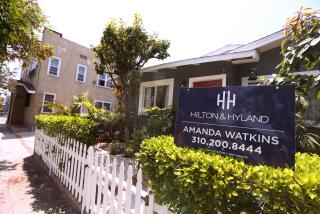Westside housing goes south
The Southern California real estate crash has finally reached the high-end areas of the Westside.
Home prices in Beverly Hills, Santa Monica and Malibu -- which continued to soar well into 2008 -- finally tanked at the end of the year, losing between 26% and 30% of their value in just a few months, the latest data show.
The sudden drop came as a surprise to Shelley Conn, who remained a believer in the myth that the wealthier parts of the Westside were immune until she put her Santa Monica house on the market last spring.
She and her husband, Bill, had been offered $2.4 million for the three-bedroom just months before, so she listed the house for $2.3 million, figuring that would make up for the lousy real estate climate. But it didn’t sell until November, after the couple dropped the price to $1.9 million.
It’s still a lot of money for a basic one-story house. But in Conn’s wealthy neighborhood, few residents thought anything would drop below $2 million.
“I didn’t believe it until the end,” Conn said.
But it’s true.
The median price of a single-family home in Beverly Hills was $2.1 million in the fourth quarter of 2008, down from $3 million in the second quarter, according to data prepared for The Times by research firm MDA DataQuick. Pacific Palisades closed the year with a median price of $2.2 million, down from a high of $2.6 million during the second quarter, and Santa Monica’s median was $1.6 million, down from $2.1 million last winter.
Even among the merely well-off in Culver City, prices have come down, to $647,500, 17% below the peak. In ZIP Code 90035, just south of Beverly Hills, the median sale price had been more than $1 million for most of 2007 but fell in the fourth quarter of 2008 to $800,000.
Brentwood’s fourth-quarter median of $2.3 million was down 11% from its peak.
“The market is absolutely correcting,” said Richard Stearns, who lives in Santa Monica and sells real estate in Brentwood. “Prices are softening, houses are taking longer to sell, the number of transactions is down.”
The downward trend is no surprise to economist Christopher Thornberg, principal of the Los Angeles consulting firm Beacon Economics, who for years angered many real estate agents by repeatedly saying the Westside would eventually see price declines just like the rest of Southern California.
“It was never a function of if,” Thornberg said. “It was always when.”
When people in entry-level homes can’t sell their properties to move up, there is less demand in the middle tier and eventually at the high end, he said.
“It takes a while, but the markets are all linked,” Thornberg said.
The numbers were bound to go down, he and others said, for the same reasons they did in less wealthy neighborhoods -- prices rose beyond what incomes could reasonably support.
Wealthy areas can stave off market woes for a while, in part because well-off homeowners usually have the resources to sustain high mortgage payments and weather downturns longer than people with less money. In many cases, the affluent can afford to hold on to a house longer while waiting for a better price.
But eventually the market catches up, and those who want to sell their expensive houses have to cut prices.
It’s happened before. Though few seemed to remember it even last year, the Westside has suffered in previous real estate downturns.
At the peak of the 1980s housing boom, for example, the Santa Monica house that the Conns recently sold went for $920,000. But in 1993, it sold for $600,000 -- a 35% drop. The Conns bought it for $825,000 in 1997, still 10% below its 1989 price.
They didn’t time the market so well the second time around, though. They bought their current house in the same neighborhood before prices started to drop, paying $3.9 million.
Kenneth Rosen, a UC Berkeley economist who studies housing markets, thinks prices will continue to fall on the Westside as they have elsewhere, but the declines won’t be as severe as in areas such as the Inland Empire, where subprime financing was rampant and foreclosures dominate sales.
The Westside “is less sensitive to the mortgage issue,” he said, “I wouldn’t be surprised to see 10% to 20% declines.”
The number of houses sold in Beverly Hills in the fourth quarter, 38, was down 47% from the same period in 2007, according to DataQuick. Santa Monica’s total of 46 sales in the fourth quarter was down 29%, DataQuick said.
Sellers have been pulling unsold houses off the market to rent instead, said Elizabeth Puro, a Westside real estate agent, but waiting the market out as a landlord is becoming less attractive as rents go down. That could eventually pull selling prices lower still.
She estimates there are three times as many houses for lease on the Westside as there were a year ago, and “that market is not as strong as it was. Someone who could have leased a house for $20,000 a month a year ago would have to lease it for $12,000 now,” she said.
The lower rents could in turn push housing prices down even more, said UC Berkeley economist Tom Davidoff.
Conn, for one, says she is prepared for that.
“We bought our previous house because we thought it would be a good investment,” she said. “This time, we bought a house we fell in love with.”
--
More to Read
Inside the business of entertainment
The Wide Shot brings you news, analysis and insights on everything from streaming wars to production — and what it all means for the future.
You may occasionally receive promotional content from the Los Angeles Times.










